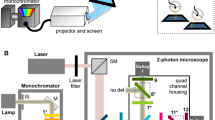Abstract
The use of a laser microbeam has allowed us to ablate specific small groups of cells deep in the larval brain of the housefly Musca domestica, without damage to overlying tissues. The ablation results in various specific alterations in brain structure and behaviour of adult flies. In the experiments described here, a set of large horizontal and vertical neurones on one side of the adult optic lobes was ablated. These neurones are known to be directionally motion sensitive and are thought to play an essential part in visual orientation of the fly1–8. However, visually guided orientation behaviour towards single objects by flies lacking the large horizontal and vertical neurones on one side was not significantly different from the behaviour of normal flies, although the response to moving gratings was reduced on the ablated side. Therefore we suggest that other sets of nerve cells are involved in the information processing of single moving objects, whereas the horizontal and vertical cells seem to be implicated in ordinary optomotor flight stabilization.
This is a preview of subscription content, access via your institution
Access options
Subscribe to this journal
Receive 51 print issues and online access
$199.00 per year
only $3.90 per issue
Buy this article
- Purchase on Springer Link
- Instant access to full article PDF
Prices may be subject to local taxes which are calculated during checkout
Similar content being viewed by others
References
Pierantoni, R. in Biokybernetik Vol. 5, 157–153 (4th int. Symp., Leipzig, 1974).
Dvorak, D. A., Bishop, L. G. & Eckert, H. E. J. comp. Physiol. 100, 5–23 (1975).
Hausen, K. Z. Naturf. 31, 629–633 (1976).
Hausen, K. in Function and Formation of Neural Systems (ed. Stent, G. S.) (Abakon, Berlin, 1977).
Eckert, H. & Bishop, L. G. J. comp. Physiol. 126, 57–86 (1978).
Eckert, H. J. comp. Physiol. 135, 29–39 (1980).
Heisenberg, M., Wonneberger, R. & Wolf, R. J. comp. Physiol. 124, 287–296 (1978).
Werhahn, C. & Hausen, K. Biol. Cybern. 38, 179–186 (1980).
Hausen, K., Wolburg-Bucholz, K. & Ribi, W. A. Cell Tissue Res. 208, 371–387 (1980).
Reichardt, W. & Poggio, T. Q. Rev. Biophys. 9, 311–375 (1976).
Poggio, T. & Reichardt, W., Q. Rev. Biophys. 9, 377–438 (1976).
Hausen, K. Verh. dt. zool. Ges. (in the press).
Meinertzhagen, I. A. in Developmental Neurobiology of Arthropods (ed. Young, D.) (Cambridge University Press, 1973).
Gundersen, R. W. & Larsen, J. R. Int. J. Insect Morph. Embryol. 7(2), 121–136 (1978).
Geiger, G., Boulin, C. & Bücher, R. Biol. Cybern. 41, 71–78 (1981).
Geiger, G. Biol. Cybern. 40, 71–75 (1981).
Author information
Authors and Affiliations
Rights and permissions
About this article
Cite this article
Geiger, G., Nässel, D. Visual orientation behaviour of flies after selective laser beam ablation of interneurones. Nature 293, 398–399 (1981). https://doi.org/10.1038/293398a0
Received:
Accepted:
Issue Date:
DOI: https://doi.org/10.1038/293398a0
This article is cited by
-
Response of Silicon Nitride Ceramics under High-enthalpy Plasma Flows
Journal of Wuhan University of Technology-Mater. Sci. Ed. (2018)
-
Fly visual course control: behaviour, algorithms and circuits
Nature Reviews Neuroscience (2014)
-
Object tracking in motion-blind flies
Nature Neuroscience (2013)
Comments
By submitting a comment you agree to abide by our Terms and Community Guidelines. If you find something abusive or that does not comply with our terms or guidelines please flag it as inappropriate.



